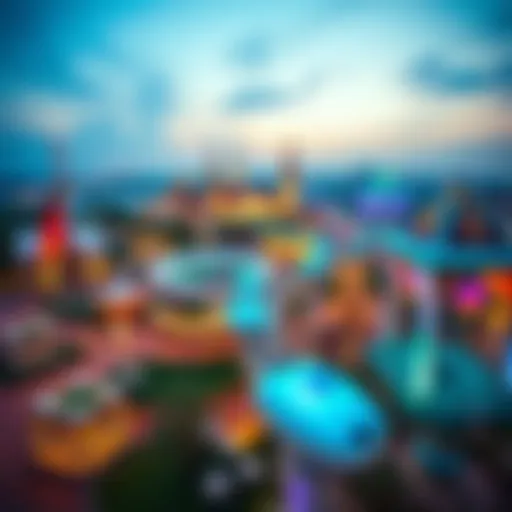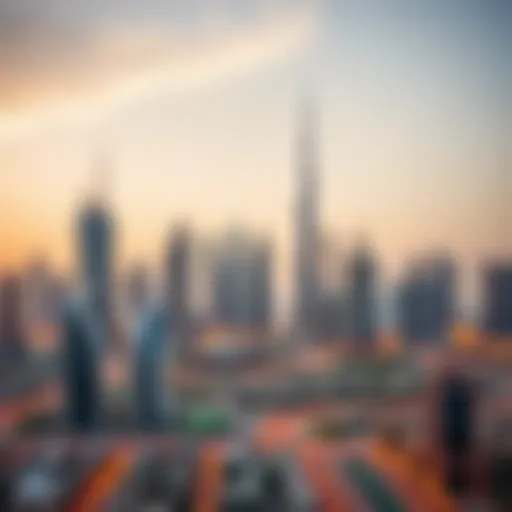Exploring Interior Design Companies in the UAE
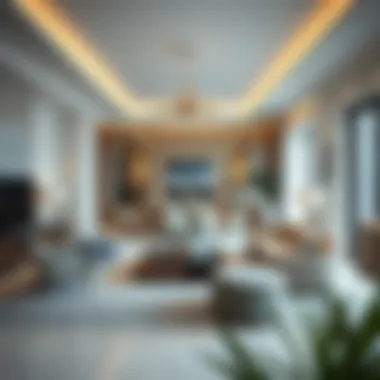

Intro
Navigating the extravagant realm of interior design in the UAE, particularly in Dubai, is akin to strolling through a gallery of architectural marvels. In a country where modern skyscrapers kiss the clouds and traditional souks radiate historical charm, the interior design landscape mirrors this visual feast. There's no shortage of brilliance found in the residential and commercial spaces, as design companies blend tradition with modernity.
Understanding the pulse of this fast-evolving sector is imperative, especially for real estate investors, property buyers, and lifestyle enthusiasts eager to elevate their living experience. These individuals not only seek a home but are after an embodiment of luxury and innovation that defines the UAE's prestigious market.
This exploration of interior design companies in the UAE aims to shed light on the critical elements of this sector. From current trends shaping the industry to predictions that could influence future developments in the real estate market, we’ll delve into it all. By highlighting key players in the field, emerging trends, and the local market dynamics, readers will gain a comprehensive understanding of what sets this region apart.
As we embark on this journey, the insights gleaned will not just satisfy curiosity but will also serve as invaluable knowledge for those looking to invest, design, or simply appreciate the stunning interiors that characterize upscale living within the UAE.
Prelims to Interior Design in the UAE
Interior design in the United Arab Emirates serves as a mirror reflecting the country’s rich cultural tapestry and architectural innovation. It is not merely a profession but an integral part of defining spaces that create experiences, enhancing functionality and beauty in homes, offices, and public venues. In a nation known for its opulence and ambition, the sector has grown remarkably, driving trends that blend traditional elements with modern aesthetics.
Understanding the dynamics of interior design in the UAE is crucial for various stakeholders, including investors, homebuyers, realtors, and architects. By diving into this vibrant landscape, one can gain insights that transcend mere decoration; the right design can increase property value, foster comfort, and promote well-being.
Understanding the Unique Context of the UAE
To fully appreciate the pulse of interior design in the UAE, one must look at the unique context in which it thrives. The UAE is characterized by its multicultural population and its rapid urban development. Each locality presents its own challenges and opportunities in design, influenced by cultural values and historic traditions.
- Multicultural Influence: The mix of nationalities living and working in the UAE contributes to a blend of styles—from Middle Eastern elegance to modern Western minimalism. Interior designs often fuse these diverse influences, resulting in spaces that are not only visually stunning but also full of life and story.
- Architectural Heritage: With iconic landmarks like the Burj Khalifa and the Sheikh Zayed Grand Mosque, architectural trends often influence interior styles. Designers take cues from the larger urban landscape, integrating local materials and motifs into their work, which both pay homage to the past and embrace modernity.
- Lifestyle and Luxury: The pursuit of luxury is palpable in daily life, as many residents expect interiors to reflect a certain sophistication. This cultural demand for high-quality finishes, state-of-the-art amenities, and exceptional craftsmanship drives the standards within the industry.
"The UAE’s interior design scene is tailored more than just to aesthetics—it’s about creating functionality within a framework of luxury that feels uniquely connected to the culture."
As we peel back the layers of this sector, we discover not only a solid business ecosystem but also stories of innovation and future potential. In this exploratory article, we'll examine the historical evolution of interior design companies, key players shaping the market, and emerging trends paving the way for future developments.
Historical Development of Interior Design Companies
Interior design within the UAE lays its roots deep in a history that melds together tradition and modernity. This section will explore the significance of understanding the historical development of interior design companies. Contextualizing the evolution of design practices not only provides insight into the aesthetic choices but also highlights how cultural transformations have influenced commercial and residential spaces in the region.
Early Influences on Design Aesthetics
To appreciate the lavish interiors we see today, it’s important to note how early influences shaped design aesthetics in the UAE. Historically, the culture was a blend of Bedouin traditions and maritime influences due to the country’s geographical positioning. Typical early designs reflected functionality and simplicity, with an emphasis on communal spaces, inviting settings, and a strong connection to nature.
Bedouin influences played a pivotal role. Tents served as flexible living spaces, often adorned with intricate handwoven textiles and local crafts. Their decorative choices, such as the use of vibrant colors and motifs, have undoubtedly influenced contemporary designers seeking to instill warmth in modern interiors.
As trade routes expanded, particularly during the 20th century, the UAE began to incorporate elements from various global styles. The exposure to international influences introduced more opulent designs, igniting an interest in luxurious materials, elaborate textures, and innovative layouts. This fusion of cultures led to an evolving aesthetic sensitive to both heritage and modern trends.
Key Points:
- Tradition: Bedouin designs celebrated community living and nature.
- Evolution: Exposure to global markets brought luxurious and varied styles to the region.
- Innovation: Early designs set the groundwork for modern interpretations that respect cultural roots.
Evolution Post-Millennium
The turn of the millennium marked a significant shift in the UAE's interior design landscape. With projects like the Burj Khalifa and the expansive developments in Dubai Marina, design companies found themselves at the forefront of a burgeoning industry. The play between glitz and grounded functionality truly gained momentum, aligning with the UAE’s vision of becoming a global hub for tourism and business.
Moreover, the advent of digital technology transformed design processes. Firms began leveraging architectural software to create innovative spaces tailored to specific client needs. This technological evolution made it easier for designers to experiment with various styles, offering customization that resonates with individual tastes while meeting the high standards expected in luxury markets.
As a result, we witness a variety of design firms thriving—from those focusing on timeless elegance to those embracing a more contemporary and avant-garde approach. This flexibility in design complements a market that continuously evolves, catering to both local tastes and global trends.
Highlights:
- Greater emphasis on luxury and technological integration post-2000.
- The rise of design firms that shaped Dubai's skyline, infusing spaces with both richness and relevance.
- A diverse array of options reflecting global standards and client expectations.
"In the UAE, interior design isn't just about aesthetics; it's about crafting experiences that connect deeply with cultural identity."
In summarizing the historical development of interior design companies in the UAE, we observe an illustrious journey that intertwines rich traditions with modern innovations. This blend not only enhances the residential and commercial atmosphere but also defines the UAE’s unique identity. As designers take cues from past influences while exploring new horizons, they remain at the heart of a rapidly evolving field that promises even greater transformations in the years to come.
Key Players in the UAE Interior Design Market
The interior design market in the UAE is a bustling hub of creativity and innovation, shaped by an eclectic mix of cultural influences. Within this vibrant landscape, a handful of key players stand out, setting benchmarks for quality, creativity, and service. Understanding these major firms is crucial for anyone looking to navigate the complex world of UAE interior design, especially for investors, homebuyers, and design enthusiasts. This section unveils not just their business models but also highlights the essence of their artistic philosophies and how they cater to the unique preferences of a diverse clientele.
Established Firms with Global Reach
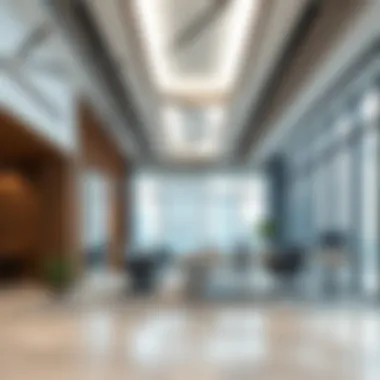

When we talk about established firms in the UAE, we’re referring to companies that have transcended local boundaries, developing a reputation that resonates well beyond the Gulf region. Firms like Godwin Austen Johnson and Foster + Partners are prime examples; they have amassed a portfolio that showcases not just craftsmanship but a commitment to understanding disparate cultural narratives. Their designs often integrate traditional motifs with modern aesthetics, creating spaces that feel both familiar and innovative.
These firms typically benefit from:
- Global Expertise: Leveraging insights from varied markets helps in infusing international trends into local projects.
- Robust Networks: Established firms often have a wide range of suppliers and subcontractors globally, which can ease the burden of sourcing unique materials.
- Comprehensive Services: From architectural design to furnishing, these firms offer turn-key solutions, making them a one-stop shop for clients.
However, with great power comes great responsibility. These monumental firms must constantly redefine their strategies to meet shifting market demands, fluctuating economic conditions, and evolving design tastes, ensuring they remain relevant in contemporary discourse.
Innovative Local Designers
In contrast to established firms, innovative local designers are often more agile, able to adapt to changes in client preferences and market conditions almost at the drop of a hat. Designers like Khalid Shafar and Zaha Hadid Architects (though globally recognized, they have localized projects in the UAE) highlight an emerging wave of creativity that often reflects local heritage while pushing design boundaries.
These local designers offer unique advantages:
- Cultural Sensitivity: Being part of the local fabric allows them to create spaces that resonate with the UAE’s rich cultural history and burgeoning modern identity.
- Sustainability Focus: Many local designers are leading the charge in sustainable design practices, incorporating eco-friendly materials and energy-efficient solutions.
- Personal Touch: Often working on a smaller scale, these designers can offer personalized service that larger firms may sometimes overlook.
Ultimately, the synergy between established firms and innovative local designers enriches the UAE’s interior design landscape. It creates an environment where both traditional and avant-garde ideas can flourish, resulting in interiors that are truly reflective of the UAE’s dynamic identity.
"The fusion of global and local design practices not only elevates the market but also amplifies the voices of emerging talents."
With an ever-evolving mix of trends, the impact of both established firms and innovative local designers lays the groundwork for a vibrant future in UAE interior design.
Understanding Client Expectations
Understanding what clients expect from interior design firms in the UAE is crucial. It’s not only about aesthetics but also deeply tied to the unique experiences each client holds, given the UAE's rich blend of cultures and lifestyles. As a melting pot of nationalities, clients hail from diverse backgrounds, shapes their desires and inspirations significantly. Interior design projects often aim to reflect not only the functional needs but also the emotional resonance of a space, creating an inviting narrative.
Catering to Diverse Cultural Backgrounds
The UAE is home to a myriad of cultural influences, and each demographic brings its own set of expectations. For example, expatriates from countries such as India and the UK may seek specific elements that remind them of home, be it color palettes or design motifs. Conversely, Emirati nationals often prefer local craftsmanship and materials that showcase and celebrate their heritage.
Designers who take time to understand these preferences can vastly improve their relationships with clients. Successful firms conduct extensive consultations, utilizing surveys or interviews to gauge expectations. This helps in crafting spaces that resonate with their clients’ identities.
- Personalization is key: Offering options that reflect clients' backgrounds and tastes leads to greater satisfaction.
- Cultural sensitivity: Understanding binding traditions around design and decoration can ensure respect and appreciation.
This approach fosters loyalty, potentially leading to repeat business and referrals, which are invaluable in the competitive UAE market.
Balancing Functionality and Opulence
Clients in the UAE often navigate a fine line between practicality and lavishness in their interior spaces. While many desire grand designs that exude luxury, there is an equally strong push for functional spaces that meet daily needs. For instance, in a bustling household, an elegant but family-friendly setting will sometimes take precedence.
Designers need to be adept at incorporating elements such as:
- Multi-functional furniture: This caters to convenience without sacrificing style.
- Efficient layouts: Smart designs can help in maximizing small spaces while maintaining an air of sophistication.
A successful project goes beyond surface-level opulence; it’s about harmonizing aesthetics with utility. When clients see their lifestyle reflected in the designs, they’re not only satisfied; they feel understood.
"It's not just about creating a beautiful space; we want our clients to feel comfortable and proud of their home."
- A senior designer from a leading Dubai interior design firm.
The true strength of an interior designer lies in navigating these expectations, thereby fostering a unique signature style while respecting each client's vision. Relying on feedback loops initiated during the design process can also alleviate the strain in communication, ensuring that even the most minute desires are realized.
Trends Shaping Interior Design in the UAE
In the realm of interior design, being attuned to the latest trends is akin to having a finger on the pulse of cultural and economic shifts. The UAE, a melting pot of innovation and tradition, hosts an array of unique design philosophies influenced by both local customs and global advancements. Understanding these trends is essential for investors, homebuyers, realtors, and designers alike as they navigate the competitive market and aim to create spaces that are not only aesthetically appealing but also functional and sustainable.
Sustainable Design Practices
Sustainability in design isn't just a buzzword; it's becoming a non-negotiable aspect of the industry in the UAE. With the government pushing for greener initiatives, interior designers are increasingly prioritizing eco-friendly materials and processes. This involves sourcing sustainable materials, such as bamboo, cork, or reclaimed wood that not only reduce waste but also add character to space. Additionally, energy-efficient lighting and appliances have gained traction, making homes and offices not just stylish but also energy-conscious.
"In the long run, sustainable design leads to healthier environments and saves costs for homeowners through efficient resource use."
A noteworthy example is the use of biophilic design elements—incorporating natural light and plant life into interiors—which nurtures well-being while enhancing the aesthetic appeal. Implementing these practices reflects a commitment to responsible stewardship of the environment and can significantly raise a property's market value. Investors and buyers are now keen on spaces that mirror these values.
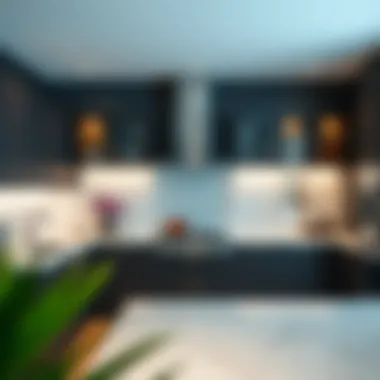

Integration of Technology in Design
As the UAE positions itself at the forefront of technological innovation, interior design is reaping the benefits. Smart home technology has made its way into contemporary design, pushing boundaries for convenience and efficiency. Imagine controlling lighting, climate, security, and entertainment systems with just a few taps on your phone or through voice commands. This not only increases the functionality of a space but can also significantly enhance one's lifestyle.
Moreover, augmented reality (AR) and virtual reality (VR) tools allow designers and clients to visualize spaces before any commitment. It provides an interactive experience where changes in design can be explored in real-time. This technology ensures that investments in design do not merely happen on paper but translate seamlessly into reality. Keeping up with these technological trends can be a game-changer for anyone involved in the real estate or design sector.
Minimalism vs. Luxury: A Balancing Act
In the eclectic landscape of UAE interior design, the battle between minimalism and luxury often unfolds. Minimalism, characterized by simplicity and the idea that less is more, speaks to practicality and modernity. This style advocates for uncluttered spaces that emphasize functionality without sacrificing beauty. In contrast, luxury design revels in opulence�—think ornate materials, rich textures, and elaborate furnishings.
Striking a balance between these two can seem challenging but creates possibilities for richer designs. For instance, a minimalist space can showcase luxury by incorporating carefully chosen statement pieces that draw the eye without overwhelming. This approach allows homeowners to enjoy opulent elements while maintaining an overall sense of tranquility and order.
Investors and homebuyers should consider both aesthetic philosophies when making decisions. The right blend can appeal to a broader audience and enhance the property’s desirability in the competitive real estate market. Ultimately, understanding how to balance these influences is crucial in a region where both trends coexist and flourish.
Challenges Faced by Interior Design Firms
In the world of interior design in the UAE, firms face a multitude of challenges that can affect their ability to operate efficiently and creatively. This section sheds light on those challenges and articulates why they matter for stakeholders such as investors, real estate developers, and even homeowners.
The interior design landscape in the UAE is vibrant and competitive. However, under this glossy surface lies a myriad of obstacles that designers must navigate to maintain their edge. The importance of understanding these challenges cannot be overstated, since they have significant implications not just for designers, but also for the broader market dynamics, profitability, and the quality of client relationships.
Navigating Regulatory Frameworks
Regulatory frameworks in the UAE, particularly in major cities like Dubai and Abu Dhabi, can be intricate and sometimes even perplexing. Different zones and projects often have specific regulations that touch on everything from safety codes to aesthetic guidelines. For instance, foreign firms need to be aware of local laws that govern construction and design. Failure to comply can lead to significant setbacks.
Interior designers must also contend with the constant changes in these regulations. What was permissible last year might be off the table this year, requiring firms to not just have a strong understanding of existing rules, but also to keep their ears to the ground for upcoming changes. This dual approach can be resource-intensive and, at times, frustrating.
Furthermore, getting design approvals from relevant authorities can sometimes feel like chipping away at granite. The bureaucratic processes may deter smaller firms from pursuing larger projects, inadvertently creating an uneven playing field.
Supply Chain Disruptions
Supply chain issues have also reared their ugly heads, impacting the timely delivery of materials and furnishings essential for interior design projects. The UAE’s design industry often relies on a mix of local and international suppliers, creating a dependency that can have repercussions when global events disrupt operations. The pandemic, for instance, threw a spanner in the works and emphasized just how fragile these supply lines can be.
With an increase in demand for high-quality, bespoke materials, firms have found it increasingly difficult to source items, leading to project delays. When timelines get extended, client satisfaction may diminish, and firms run the risk of damaging their reputations. Moreover, the rising costs of imported materials can inflate budgets, posing a challenge for both designers and their clients.
Influence of Architecture on Interior Design
The intricate relationship between architecture and interior design is a melody composed of forms, colors, and atmospheres that sings the stories of spaces. In the context of the UAE, where modern skyscrapers pierce the sky and traditional designs whisper tales of heritage, this influence is particularly profound. Understanding how architectural styles affect interior design practices can equip investors and homeowners with the knowledge to enhance the value and ambiance of their properties.
Effective interior design doesn't just promote aesthetics; it interacts deeply with the structure itself. An interior must respect its architectural surroundings to create a holistic environment that feels seamless and organic. Designers often look at an architectural framework as a guiding blueprint, infusing their creative vision while staying within the constraints and opportunities it presents.
Architectural Styles and Their Impact
The UAE showcases a diverse spectrum of architectural styles, each carrying distinctive characteristics that sway how interiors are conceived. Here are some key styles and their influence:
- Islamic Architecture: This style reflects the region's rich cultural and historical background. Elements like intricate geometric patterns and textures influence interior spaces, leading to designs that feature arabesque tiles, ornate calligraphy, and rich colors. Spaces become not just functional but also narrative, providing a context rich in meaning.
- Modernist Architecture: Emerging predominantly in Dubai, this style emphasizes minimalism and functionality. Interiors often use open-plan layouts, promoting spaciousness and light. This formatting invites furnished elegance—think sleek furniture and neutral palettes that accentuate the structural lines of a room.
- Postmodern Architecture: Adding a layer of playfulness and irony, this architecture often contrasts with its predecessors. Interiors inspired by postmodern elements include bold patterns and eclectic furnishings, harmonizing the newfound creativity inside structured walls.
- Brutalism: Though less common in the UAE, the raw concrete aesthetic of Brutalism influences some modern designs, where interiors strive for authenticity and unembellished simplicity. This can usher in a trend of slightly rugged textures and minimalistic designs that emphasize function over form.
"The synergy of architecture and interior design creates spaces that are not just lived in but also experienced in a meaningful way."
Awareness of how these styles interact with interior design can direct buyers toward making choices that resonate with their lifestyle needs and aesthetic preferences.
Additionally, an increasing trend involves integrating sustainable principles into architectural frameworks, subsequently influencing interior design. For example, the usage of natural light and eco-friendly materials can dictate how space is organized and what designs are permissible.
Further Reading: Wikipedia, Britannica
Interior Design Exhibitions and Events in the UAE
The UAE's reputation as a global hub for design and luxury is firmly buttressed by a vibrant calendar of exhibitions and events dedicated to interior design. These gatherings are critical for several reasons: they foster innovation, unite designers with clients, and showcase an array of trends shaping the industry. Events held in places like Dubai, known as a melting pot of cultures and ideas, serve not only as platforms for showcasing design prowess but also as arenas for networking, education, and inspiration.
Interior design exhibitions in the UAE often attract a diverse audience, from seasoned architects and enthusiastic homeowners to curious investors and expats exploring design options. The benefits of attending these events are twofold; they provide insights into the latest design trends and enable direct interaction with influential designers and companies. Successful collaborations often sprout from these interactions, allowing for an exchange of ideas that can lead to groundbreaking projects.
Notable Annual Events
Several key exhibitions and events mark the interior design calendar in the UAE, warranting attention from anyone involved in the lifestyle or investment sectors:
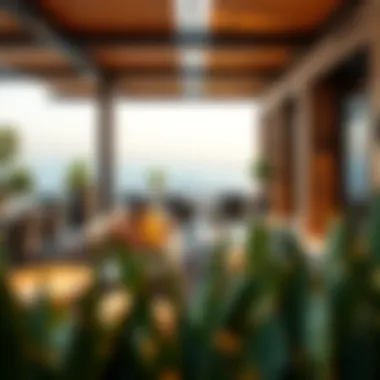

- Dubai Design Week: This flagship event, typically held every November, draws crowds with its extensive program featuring exhibitions, workshops, and talks. Attendees can interact with local and international designers, making it a hotbed for fresh ideas.
- INDEX Dubai: As one of the region’s largest interior design showcases, INDEX combines a trade show with a comprehensive seminar program. It’s an excellent opportunity for designers to explore products and network.
- Middle East Architectural Summit: Focused on architecture and construction, this summit explores the intersections between architectural design and interior spaces, providing insights into the future direction of industry standards.
- Abu Dhabi International Book Fair: While it may not be purely about interior design, this event often features sections dedicated to design literature, which can profoundly influence interior aesthetics and practices.
- Art Dubai: This prominent art fair often features installations and exhibits that blur the lines between art and design. Exploring these connections can open up new avenues for creativity within interior spaces.
Each of these events presents a unique opportunity for learning and collaboration, making them indispensable for anyone serious about grasping the subtleties of the UAE's interior design landscape. Given the rapid growth in the real estate market and the ongoing investment in luxury lifestyles, being present at these exhibitions is not just beneficial, it's critical for keeping pace with the industry's evolution.
"In a world where luxury meets creativity, design exhibitions are the crucibles where the future is forged."
For those looking to delve deeper into the nuances of interior design in the UAE, participating in these events provides a competitive edge, offering insights that could guide their future endeavors. The connections made here can elevate projects from mere ideas to stunning realities.
Collaborations Between Designers and Developers
In the vibrant interior design landscape of the UAE, the synergy between designers and developers plays a crucial role in manifesting exquisite environments. This relationship is not merely transactional; it is a dynamic partnership that combines vision with practicality. Designers bring artistic flair, while developers ensure that these visions are realized within the constraints of budget, timelines, and regulatory frameworks. Understanding how these partnerships function offers valuable insights into the industry, most notably when considering the way such collaborations improve overall project outcomes.
Benefits of Collaborations
When thinking about why partnerships are important, several key benefits become evident:
- Holistic Vision: A collaborative approach enables a cohesive strategy. Designers and developers share their unique insights, leading to a more integrated and functional result.
- Efficiency: Working together from the outset can streamline processes, ensuring that both the design feasibility and project execution align seamlessly.
- Cost-effectiveness: By addressing potential issues early on, such collaborations can avert costly revisions later. This foresight is particularly crucial in the fast-paced UAE market, where speed is essential without compromising quality.
- Innovation: Pairing the creativity of designers with the practical experience of developers fosters innovative solutions. This is especially true in sectors like hospitality, where aesthetic appeal must coexist with functionality.
Key Considerations
However, it’s not all smooth sailing. Certain considerations need mindful attention:
- Communication: Regular and open dialogue between designers and developers minimizes misunderstandings. A project may suffer if either party is left in the dark about changes or decisions.
- Role Clarity: Clearly defining responsibilities helps prevent overlaps and ensures accountability on both sides.
- Cultural Sensitivity: Especially in the UAE, where diverse backgrounds converge, understanding cultural nuances can enhance project acceptance and market appeal.
"The successful outcome of a project often rests on the degree to which designers and developers collaborate with trust and transparency."
Case Studies of Successful Partnerships
Examining specific case studies can illuminate the effective strategies used in these collaborations.
- Burj Khalifa's Interior Design: The world’s tallest building, designed by Adrian Smith of Skidmore, Owings & Merrill, worked closely with Emaar Properties. The integration of luxury components and functional spaces demonstrates how communication can enhance aesthetic and operational success.
- The Louvre Abu Dhabi: In its creation, designers at Atelier Jean Nouvel collaborated intensely with developers to harmonize the artistic vision with the practical needs of construction in a challenging environment.
- Dubai Marina's Residential Towers: Collaborations between multiple designers and the developer Emaar utilized shared spaces for community builds, where communal views were prioritized while still respecting individual privacy, showcasing a superb blend of function and luxury.
Through such exemplary partnerships, the interior design scene in the UAE not only thrives but also sets benchmarks for global practices. Investors, homebuyers, and other stakeholders benefit immensely from the results achieved when creative minds and construction experts join forces.
The Future of Interior Design in the UAE
As we look ahead, the trajectory of interior design in the UAE indicates an exciting convergence of inspiration, technology, and cultural nuances. Understanding how the future of this industry unfolds is crucial for anyone involved, whether they’re investors, homebuyers, realtors, or architects. The interplay between innovative design practices and the local market's demands will shape exceptional living and working spaces.
Emerging Technologies and Trends to Watch
- Smart Home Integration
The rise of Smart homes is not just a fleeting trend; it’s becoming a mainstay in the UAE. With the likes of IoT devices streamlining daily tasks, designers are exploring ways to incorporate technology without compromising aesthetic value. Connected systems for lighting, security, and temperature control redefine how spaces are interacted with. For example, a homeowner might control their home's ambiance from a smartphone app seamlessly. - Sustainable Materials and Practices
There’s a growing emphasis on sustainability in design—material choices are shifting from conventional to eco-friendly options. Natural resources like bamboo and reclaimed wood are gaining traction. Such materials not only look good but also leave a lighter footprint on the environment. Designers who prioritize sustainability are not only doing the right thing but are also catering to a clientele that values ecological responsibility. - Virtual Reality (VR) and Augmented Reality (AR) in Design
Technologies such as virtual and augmented reality are revolutionizing how designers present their concepts. Imagine walking through your future space before a single piece of furniture is placed. AR and VR allow clients to visualize and interact with designs quickly. This immersive experience can inform better design decisions, saving both time and resources for everyone involved. - Cultural Infusion in Design
The future also sees a growing appreciation for the rich tapestry of cultures that constitute the UAE. Designers are likely to draw inspiration from the myriad traditions that flourish in this melting pot. This cultural infusion contributes to unique, personalized spaces that resonate with a sense of belonging. - Health and Well-being Solutions
With increased awareness around mental and physical health, the design focuses on well-being. Concepts such as biophilic design—bringing nature into indoor spaces—are gaining popularity. Incorporating plants and natural light can create environments that promote relaxation and creativity, essential for modern living.
Interior design in the UAE is evolving from opulence to a blend of functional luxury and sustainability, reflecting changing client needs.
These trends illustrate how the future of interior design in the UAE is not just about aesthetics; it’s a holistic approach that combines comfort, innovation, and cultural significance. For stakeholders in the industry, recognizing and adapting to these trends is not merely beneficial but essential in navigating the competitive market. Designers will need to cultivate an openness to new technologies while balancing the rich traditions of the UAE, ensuring that the spaces they create are both timeless and contemporary.
End: The Evolving Landscape of Interior Design
The interior design landscape in the UAE is akin to a rapidly shifting mosaic, where innovation meets tradition in vibrant harmony. Understanding this evolution is more than just an academic exercise; it is essential for anyone engaged in the real estate market—whether they are investors, buyers, or professionals in the field. As the UAE continues to redefine luxury and lifestyle, particularly through its metropolitan centers like Dubai and Abu Dhabi, interior design becomes a pivotal aspect of this transformation.
To grasp the significance of the evolving interior design scene, one must consider several key elements. Emerging trends focus heavily on sustainability, which has gained traction among designers responding to both environmental considerations and client demands. Integrating elements of nature into spaces, such as biophilic design principles, has become a priority, bridging the gap between inside and outside environments.
The role of technological advancements cannot be understated either. Smart home technology for seamless automation is becoming increasingly integrated into residential and commercial spaces. This not only heightens convenience but also transforms the lived experience, appealing to a tech-savvy client base that values both aesthetics and functionality.
Given these factors, we can outline some benefits stemming from the evolving nature of interior design in the UAE:
- Cultural Reflection: Interior design now mirrors societal values that emphasize diversity and richness of heritage, combining various cultural elements from Arab, Asian, and Western influences.
- Enhanced Property Value: Up-to-date interior design practices can significantly boost property value, making it an attractive proposition for potential buyers and investors alike.
- Client-Centric Approaches: Firms that adapt to client expectations, customizing designs to suit personal tastes and lifestyles, are more likely to thrive in this competitive market.
However, considering the complexities involved, potential pitfalls are present as well. Navigating regulations concerning building codes, sustainability requirements, and cultural sensitivities involves a steep learning curve for those in the industry. So, both newcomers and seasoned professionals must stay updated on legislative changes, market dynamics, and emerging trends.
Overall, the interior design sector in the UAE is characterized by a multi-faceted approach that considers aesthetic innovation and practical requirements. This underscores the reality that design is not merely about making spaces look appealing but creating environments that enhance quality of life.
In summary, the evolving landscape of interior design is a reflection of broader societal trends, influencing and influenced by economic, cultural, and environmental factors.
Final Thoughts on the Industry
As we reflect on the state of interior design in the UAE, it is clear that the industry is at a crossroads. Designers and firms must find equilibrium between creativity and pragmatism. Not only do they need to present visually appealing solutions, but they also have to be conscious of the environments they create, ensuring their designs are sustainable and relevant.
Investors and homeowners seeking to make educated decisions should remain attuned to these shifts. The journey of interior design in the UAE is one filled with potential, yet fraught with challenges that require careful navigation. The key will lie in recognizing the interplay between emerging trends and traditional values, forging a path that celebrates both flair and functional living.
Creating a successful design can mean the difference between a fleeting trend and timeless elegance. As a result, ongoing education and adaptation will serve as vital tools for all stakeholders involved in this vibrant marketplace.









